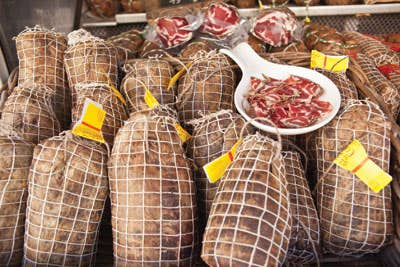
The Art of the Cure: Corsican Charcuterie
Traditional Corsican charcuterie is made using the same centuries-old methods—salting, air-curing, smoking, and cave-aging—that were likely carried over from Italy during the long periods of Genoan rule. The calling card of Corsican charcuterie is rich marbling, which owes to the free-range, chestnut-fattened Nustrale pigs, a black-skinned breed that is related to the island's native wild boars. Curing was customarily carried out during the tumbera, or pig harvest, which takes place in mid-December. Though the tumbera is now a ceremonial event, Corsica's charcuterie makers—mostly farmers and rural artisans—still slaughter their animals in early winter and break them down to make the four major types of charcuterie: coppa (smoked filet, pictured), lonzu (dry-cured loin), prizuttu (dry-cured ham), and figatellu (smoked liver sausage). All are typically enjoyed as a precursor to a meal, though many cooks like to use them, especially figatellu and prizuttu, to enrich soups and slow-simmered beans and vegetables.
Keep Reading
Continue to Next Story










